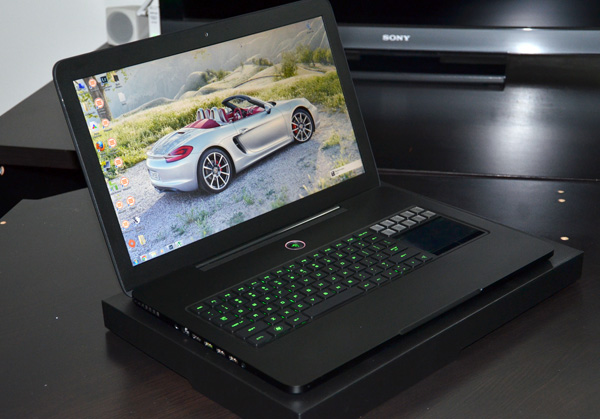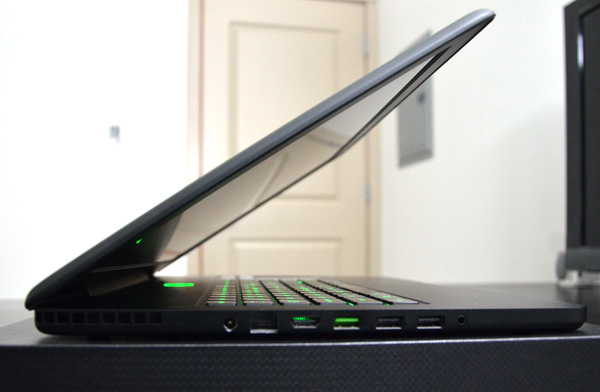The Razer Blade Review
by Vivek Gowri & Jarred Walton on March 15, 2012 3:01 AM ESTThere is something absolutely arresting about the Blade’s overall aesthetic. It’s big, but so strikingly thin at the same time, and the matte black paintjob is like a visual black hole. The overall effect is eye-catching, breathtaking, and will cause random passerby to stop and ask questions.
The design language is really, really clean and rather understated, two things you don’t expect from most gaming notebooks, while still keeping a sense of flair about it. The lid has two ribs vertically arranged on either side of the glowing Razer logo on the back, breaking up the monotony of the otherwise flat profile of the lid. Everything here is very uniformly laid out—lots of rectangles with radiused edges, no extraneous design elements, but unlike Apple’s portables, there’s no feeling of overwhelming sterility. Apple has taken the minimalist design philosophy so far that the MacBook Pro design language feels almost soulless.
The Blade doesn’t have that problem. The flat black aesthetic is offset by green accents—lots of them. The Razer logo on the back lights up in green, the power button has a Razer logo that glows green and pulsates almost like a heartbeat, the USB 3.0 port is green, the keys on the keyboard are green, a lot of the UI elements of the Switchlade panel are green, the list goes on. The industrial design is very clean, but what’s impressive is the overall polish in the design and how the whole thing ties together. It’s the little things—the attention to detail borders on obsessive, and that’s very good to see.
No matter what you think about the specs or the price, it’s impossible to ignore the fact that the Blade is a gorgeous, gorgeous device. It’s very obviously built to a high standard of build quality, with a machined aluminum unibody chassis that, even being so thin, is very structurally rigid. The lid and hinge are also pretty sturdy feeling, and the keyboard has no flex. Nothing about the look and feel of the Blade suggests anything less than a truly premium product.
In terms of ports, the Blade is pretty sparse. There’s one USB 3.0, two USB 2.0, HDMI, gigabit Ethernet, combo headphone jack/line in, and AC power all on the left side of the machine, as well as a Kensington lock on the right side. I’d definitely have liked to see an SD card slot here, along with one more USB 3.0 port, but given the form factor, you can understand why the Blade doesn’t have too much in the way of ports. The reason almost all the ports are on the left side is so that when at a desk using a mouse, gamers won’t ever run into the peripheral devices connected. Close to the back of the unit, there’s vents on either side; GPU on the right, CPU on the left.
The front is also completely clean, other than the angled cutout for opening the latch-less screen. The back of the system is dominated by the hinge, a right-angled piece that borrows from Apple’s playbook for designing low-profile hinges. The bottom of the system is also pretty minimalist, with chrome-ringed heat vents on the right and left sides, FCC information silk screened onto the body, and the Windows COA sticker. The heat vents are nice in that they are angled such that they blow air towards the rear of the notebook, away from the user.
The LCD bezel is thicker than I’d like, but the larger footprint was probably necessitated by the super-thin form factor. Above the display, we find the 2.0MP webcam, mic, and light sensor, while below it we find the highly stylised Blade logo rendered in glossy black. Against the metallic matte black of the rest of the interior, it’s understated yet incredibly cool looking.
The rest of the interior is pretty interesting. First things first, there’s no touchpad in the conventional sense—what happened, effectively, is that the touch-based input device got moved to where the keyboard’s number pad would be, leaving the area underneath the keyboard completely free. The keyboard and Switchblade are important enough to deserve their own page, but the rearranging of the touchpad enabled Razer to do some interesting things with the design. There’s much more space above the keyboard than you’d typically find on a notebook, something that Razer took advantage of by piping most of the heat generated by the CPU and GPU to that area. It’s not somewhere where people typically touch their computers, unlike the bottom or the palmrests, so engineering the thermal system to move heat towards the rear left corner was a good idea. Razer put vents on both sides of the Blade, but a majority of the heat is exhausted from the one on the left because the design team didn’t want hot air blowing on the mouse hand (when using an external mouse). It’s touches like this that impress—it’s rare to find this kind of polish or attention to detail in a company’s first computer.





















95 Comments
View All Comments
geniekid - Thursday, March 15, 2012 - link
I will echo the general sentiment that this thing is both overpriced and inadequate for gaming, but at the same time it's nice to see a company really try and increase the overall build quality of a laptop.The problem is when you take big risks like this you have to get it right the first time, or you have to have enough resources in reserve (and enough faith from the powers on high) to iteratively improve the product until it's good enough. I hope Razer gets into the latter category and succeeds.
kenyee - Thursday, March 15, 2012 - link
Cost unfortunately is too high. And what's with only 2 memory slots on a giant 17" laptop?The rest actually looks pretty cool. If Apple released something like this, their fanboys would be all over it, despite the price ;-)
Hopefully high res displays will drop in price and ivy bridge/kepler will make this a lot more interesting...
Felix_Ram - Thursday, March 15, 2012 - link
I can't help but think that Razer is out too early on the market, and that they have the wrong cpu company in their machine. Their concept is good, it's just not competitive enough.If they were launched with the coming AMD APU, the topline trinity, and they at the same time managed to crossfire the APU with an AMD GPU, without changing the machines design, they might have a much more competitive product on their hand.
JarredWalton - Thursday, March 15, 2012 - link
No way. Trinity very likely won't even be as fast as Sandy Bridge for CPU tasks, the APU graphics won't be as fast as a GT 555M by a long shot (about 33% slower I'd wager, though I could be wrong), and AMD's switchable graphics and dual graphics still has serious driver issues in my experience. You don't spend basically $1500 on the industrial design and build quality only to ship it with a slower CPU and GPU.VivekGowri - Friday, March 16, 2012 - link
Agree with the "too early to market", disagree with everything else. If they had waited a couple of months, this could have Ivy Bridge and Kepler, and they could have used the extra month or two to fix some of the more pressing stability issues that plagued Switchblade at launch. It's a bit of a pity that they didn't, actually.tonyn84 - Thursday, March 15, 2012 - link
I really, really like the form factor of this, I think moving the trackpad to the right side is brilliant (sorry lefties) and really hope to see this in future gaming laptops. The price though, I can't even get close to justifying for the performance. With any luck though they'll be able to have a couple different models at some point after ivy bridge is available. If they can get is closer to $1500 I'd seriously consider it, even with slightly less bells and whistles.Bees - Thursday, March 15, 2012 - link
What I'd like to know is why the facts that the keyboard and touchpad can both go unresponsive on their own wasn't treated in this review like the showstopping bugs they are. I've seen it firsthand with someone else's Blade, it's ridiculous that something so widespread (according to the support staff on the phone) made it past QC on such an expensive piece of tech.JarredWalton - Thursday, March 15, 2012 - link
I don't know if Vivek ever had this happen, but I certainly didn't encounter that problem in the several days of testing I did. Most likely it is a QC bug and your friend got bit, or else something else is going on. That said, I do not like the keyboard or touchpad at all. Vivek had more time to adapt so I left that to him to discuss, but I found the touchpad to be an expensive gimmick.IKeelU - Thursday, March 15, 2012 - link
Finally a company willing to invest in portability, good design and quality, that isn't called Apple. I would buy this without even thinking of it as a gaming laptop, if only they could reduce the noise level.Considering how many actually spend 2k+ on Macbooks, I'm astonished that it took a peripheral company to invent such a desirable high-end laptop. I hope this sells well, and I hope Dell, HP et al. take note.
FormulaRedline - Thursday, March 15, 2012 - link
This product is an early April fools joke, right? I saw "Gaming" and "1080p" followed shortly by "555m" and basically stopped reading. That is until I saw the almost $3k price tag...then I had to post.You can pretend Marketing screwed this up by claiming it to be a top of the line gaming product when it's really more a 17" ultrbook/MPB -like machine, but Razer is SUPPOSED to be high end gaming. 555m's belong in sub-$1000 machines that can do some gaming on the side at lower resolutions.
Meanwhile, it's got a great processor. Oh good, now we can bottleneck the @#*$ out of it. Has anyone at Razer ever even built a computer?